
If you are considering getting a reptile pet for the first time, you likely won’t go wrong with a bearded dragon.
Bearded dragons are fascinating and unique reptiles that make excellent pets. They are a great choice for first-time reptile keepers because they are relatively docile and easy to care for.
It is important to do your homework before bringing your first bearded dragon home, so you can understand what their needs are and how best to provide for them. Our care sheet is a perfect start, and it will help answer many of your questions.
Bearded Dragons – The Facts
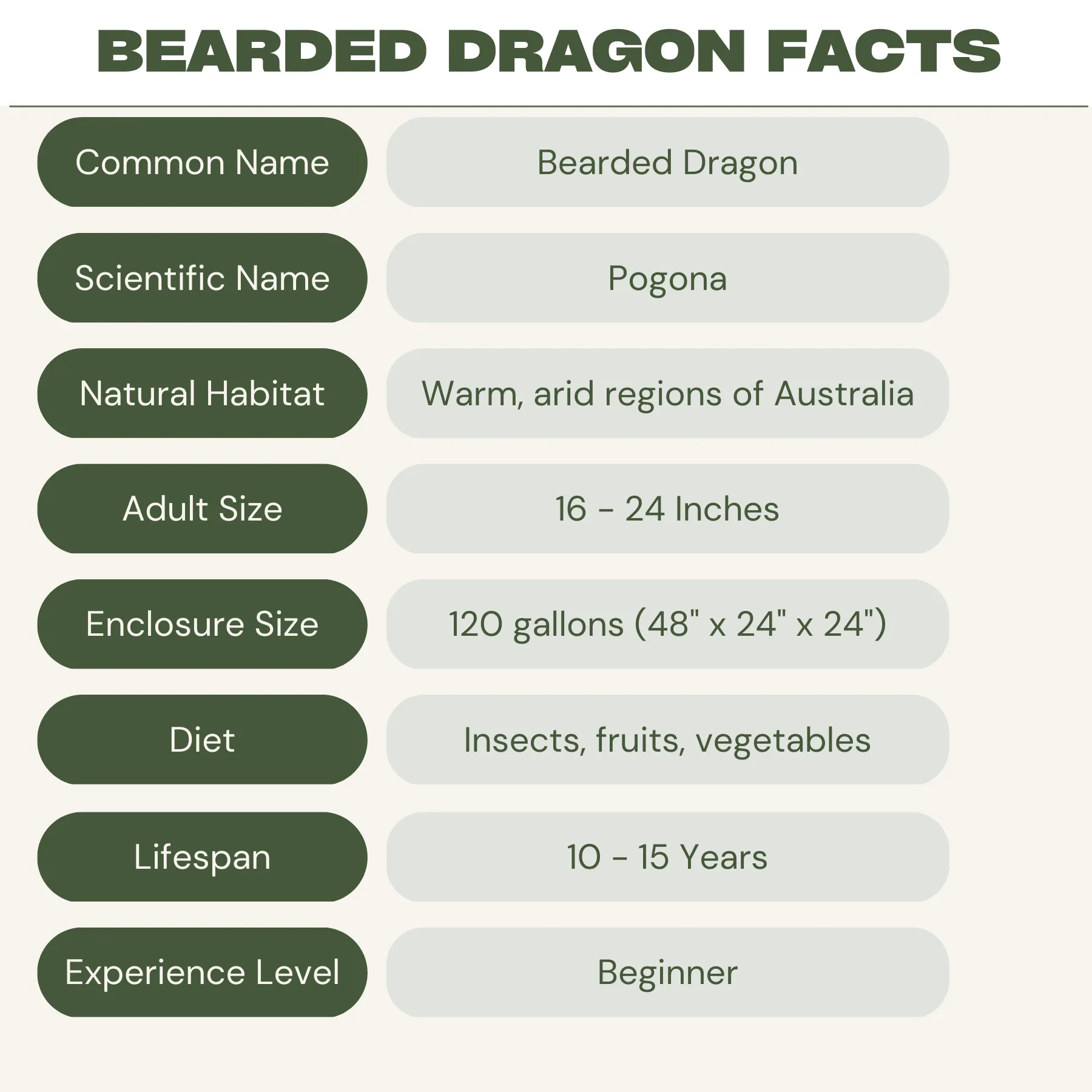
Where Do Bearded Dragons Live?
Wild bearded dragons are found throughout most of the arid, semi-desert regions of Australia. They can be found in subtropical woodlands, scrublands, coastal regions, savannahs, and in the interior deserts.
These reptiles are semi-arboreal, meaning that although they spend a lot of their time at ground level, they can also be found in trees and shrubs. They often seek perches above the ground when basking.
Bearded Dragon Appearance, Colors, And Morphs
One of the most interesting features of the bearded dragon is their “beard” of spikes. When a bearded dragon is startled or threatened, it puffs out its throat to make them look larger and more intimidating.
The throat spikes will also darken, which you can see in the video below.
Bearded dragons have somewhat flattened bodies, broad wedge-shaped heads, and sturdy legs. Their spikes run along the sides of their body as well as their throats. Tails are generally as long as the body.
The natural colors of wild bearded dragons are shades of grey, brown, and tan/yellow, with males having brighter colors than females. Selective breeding has resulted in over 25 color morphs.
Pet bearded dragons can now be found in a wide range of colors, including black, white, red, and orange, to name a few. There are morphs with different color patterns as well, such as striped or splotched.
How Big Do Bearded Dragons Get?
Bearded dragons differ in size depending on the specific species. Some can be as small as 4-6 inches (Pogona microlepidota), while others are much larger.
The Central Bearded Dragon (Pogona vitticeps) is the most common pet species and one of the largest. Any further information we provide below is specific to this species.
Hatchling bearded dragons are about three inches long and weigh about four grams. They grow quickly, reaching their full weight after they reach sexual maturity (usually between 11-12 months of age, although some reach their full size at 18 months)
Adult bearded dragons can reach lengths of 18-24 inches from head to tail. Males tend to be larger than females, with males typically being 21-24 inches, and females 18-20 inches.
The weight of a fully mature bearded dragon should be between 380 grams (16-inch females) and 510 grams (24-inch males). If your bearded dragon weighs more than this, then it is considered obese.
Bearded Dragon Lifespan
The average lifespan of a captive or pet bearded dragon is 8-10 years. With optimum care, management, and diet, they can live for as long as 15 years.
How To Care For Bearded Dragons
Knowing how to provide for a bearded dragon’s needs is essential to giving them a long and happy life. Let’s take a closer look at what it takes to provide your bearded friends the care they deserve.
Bearded Dragon Tank Setup

Tank Size
The general rule for
Hatchlings and juvenile bearded dragons can be kept in smaller tanks for a while, but as they grow they will need to be moved to a
Adult bearded dragons grow up to 24 inches long and will need a
A 120-gallon reptile tank (like this one) or terrarium that is 48″ x 24″ x 24″ should provide ample space for one adult bearded dragon. Make sure that the enclosure includes a screened top that is securely fastened in place to prevent escapes.
Temperature Requirements
Bearded dragons use their environment to regulate their body temperature. They need a basking area that is quite warm as well as a cool area where they can go to prevent overheating.
The surface temperature of the basking area needs to be between 108-113°F (42-45°C), while the surface temperature of the cool side of the
The daytime air temperature should range from 72-99°F (22-37°C) between the cool and hot sides, and cooler at night – between 65-75°F (18-24°C).
This mimics a normal environment and provides a range of temperatures that allow the bearded dragon to regulate its body temperature.
Do Bearded Dragons Need UVB Light?
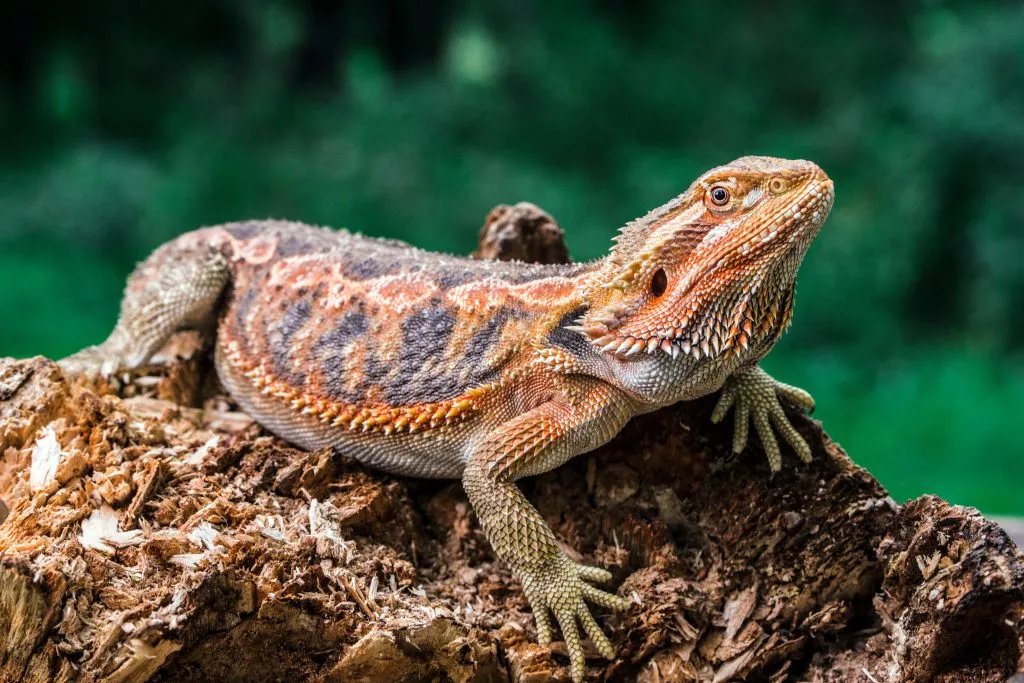
UVB lighting is essential for preventing calcium deficiency and metabolic bone disease in bearded dragons. Calcium in their diet can only be properly absorbed and used by the body if there is also sufficient vitamin D3 available.
Most of the bearded dragon’s vitamin D3 is produced by the skin in the presence of UVB light, so it is important to select a high-quality UVB light to keep them healthy.
We recommend lights such as the Exo Terra Solar Glo or the Zoo Med Powersun which provide UVA, UVB, and heat all in one lamp.
Tip: You can find out more about UVB lighting for bearded dragons in this article.
Basking Light Requirements
If you are using a UVB fluorescent-type bulb that does not give off heat, your bearded dragon is going to need something else for a heat source. This is accomplished by the use of a basking lamp, such as this one.
Many reptile owners simply use a regular halogen bulb, which is fine. Whichever bulb you use, pairing it with a quality heat reflector base (like this one) will help maximize heat output.
There is no hard and fast rule about how far away from the surface the basking light should be since every light and habitat is slightly different.
Our suggestion is to buy an infrared surface temperature sensor and adjust the height of the basking lamp up or down until the right surface temperature is achieved.
Light Setup
Remember that there needs to be a cool side and a warm side to the bearded dragon’s habitat. This is accomplished by placing the light to one side of the
If your UVB light is a long fluorescent bulb, it must be shorter than the
Do not place lights above the
What Is The Best Light Cycle For Bearded Dragons?
Bearded dragons do not need light at night. Light will disturb their sleep, so they should have regular periods of uninterrupted darkness.
The light cycle varies by season, with 8-10 hours of darkness in the summer and 12-14 hours of darkness in the winter. You can learn more about bearded dragons’ light cycle requirements here.
Although they do not need light at night, if your house temperature gets cold during the night they may need a heat source to keep them warm.
Monitor the habitat temperatures during the night, and if it falls below 65°F (18°C) then consider getting a ceramic heat emitter for nighttime use.
Substrate
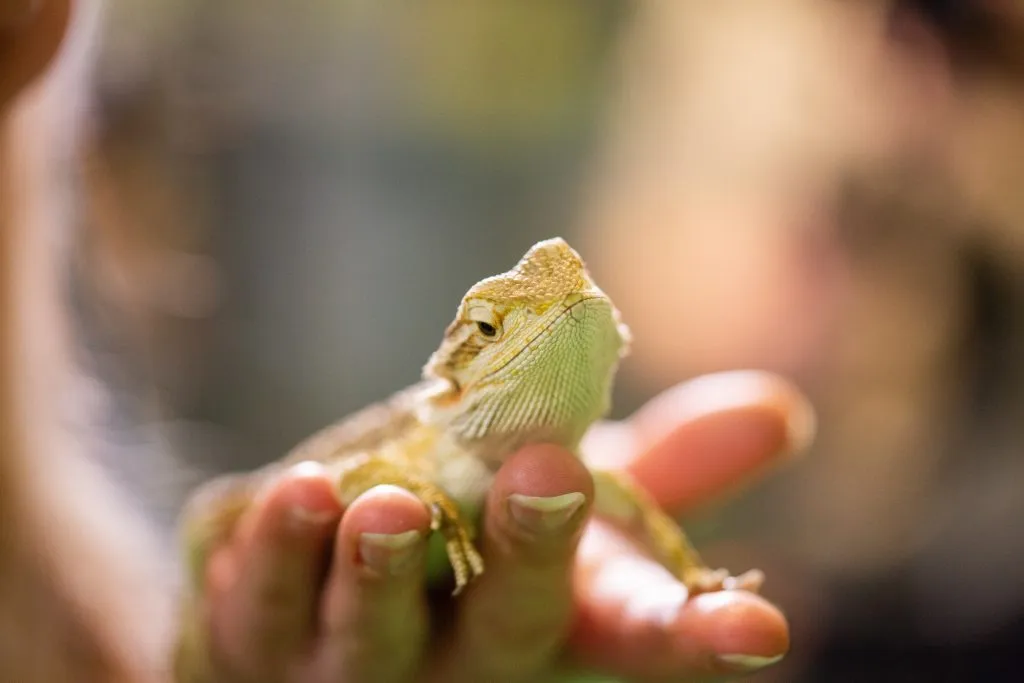
We often see materials such as ceramic tiles, reptile carpet, and newspaper recommended for bearded dragon habitats because they are easy to clean. However, easy-to-clean isn’t what your bearded dragon needs.
Bearded dragons like to dig! Their habitat should therefore be set up to allow for them to do this. But how do you do that?
Our preference is a 4-6″ deep mixture of 30% Arcadia Earthmix Arid, 20% Zoo Med Excavator Clay and 50% sand. This compacts into a fairly firm surface that is comfortable for walking but still allows digging and burrowing.
Do be careful about what sand you use though, as not all sands are made equal and some are downright dangerous for bearded dragons.
Our article on this subject will provide you with everything you need to know about using sand in bearded dragon habitats.
Humidity
Bearded dragons require humidity levels similar to that of the semi-arid regions of Australia where the species originates from. Daytime humidity levels in their habitats should be between 30-40%.
Measuring the humidity levels in your beardie’s
High humidity can cause health problems, such as respiratory disease, in your bearded dragon. You can reduce humidity by increasing ventilation, moving the water bowl to the cool side of the
Low humidity can also cause problems, especially with shedding. Increase habitat humidity levels by placing the water bowl in the warmest part of the
Tip: In our beardie humidity guide, we show you exactly how to get the humidity in your
tank right.
Tank Décor
Your bearded dragon’s furniture needs are simple: something to hide under, something to climb and perch on, and a basking spot.
- Hide: Simulates a burrow, which is a safe place they can go when they are feeling stressed, to sleep, or during brumation. The Pangea Reptile Hide Box is a popular choice.
- Basking site: An elevated surface such as a rock or a log where they rest while basking.
- Climbing furniture: Beardies are semi-arboreal, meaning they like to climb at times. Sturdy branches are great for this. You can also place a hammock in one corner of the
tank for your beardie to climb into. - Plants: Real or fake plants will add interest and stimulation to your beardie’s habitat. Fake plants must not have small parts that can be pulled off and swallowed. Real plants must not be toxic (you can read more about plants for bearded dragon enclosures in this article).
How To Clean A Bearded Dragon’s Tank
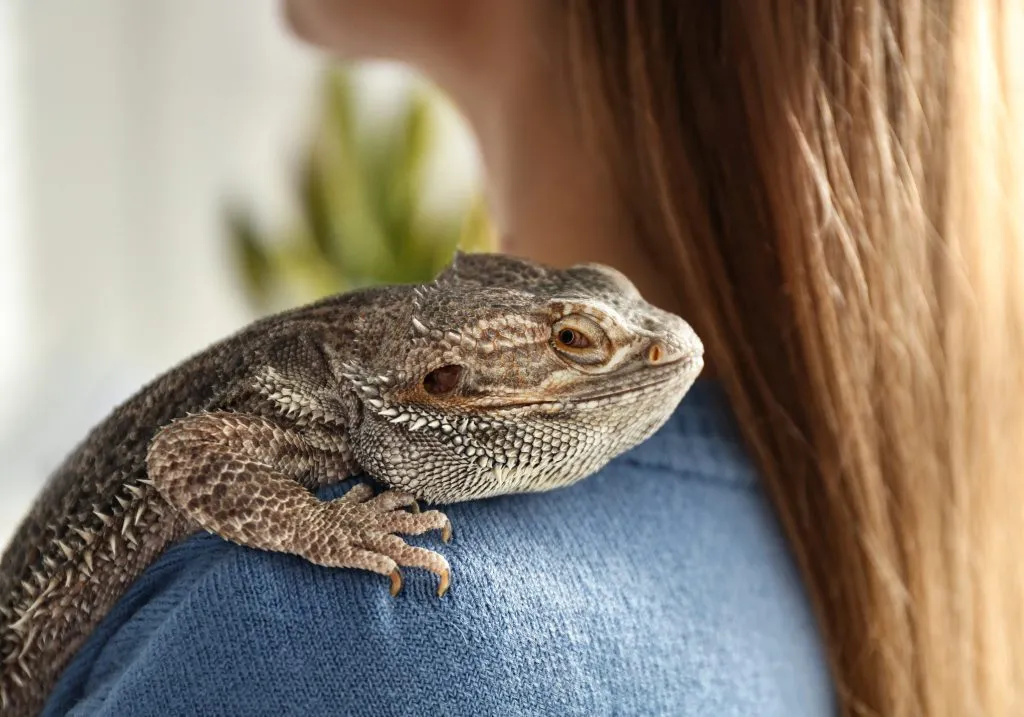
Spot cleaning should be done every day no matter what substrate you are using. If your bearded dragon poops in its water dish or on other furniture, you will need to clean and wash those as soon as possible.
Newspaper or paper towel should be completely removed and the bottom of the
Natural substrates such as the soil, clay, and sand mix need only be completely changed every three months.
To clean the
Once everything is clean and dry, refill the bottom of the
It is best to remove your bearded dragon from the enclosure while cleaning because it will stress them. Return it to its enclosure only after the cleaning is finished and everything has been put back in its place.
Bearded Dragon Diet

Feeding your bearded dragon is easy! Here are some tips to ensure that your pet gets the nutrition they need.
What to Feed
Bearded dragons are omnivores, meaning they eat both plants and animals. Although they may eat small animals in the wild, such as small lizards and mice, we do not recommend feeding meat to these reptiles.
Feed about 75% of the baby bearded dragon’s diet as insects, including grasshoppers, crickets, various worms, and roaches. The other 25% should consist of greens and, if you want, fruits on rare occasions.
The insects should be purchased commercially, since “wild” insects may harbor unknown parasites or chemicals that they have picked up from the environment.
The diet of adult bearded dragons should consist of 80% greens and only 20% insects.
Spinach, kale, mustard greens, and dandelion greens are all good choices. Carrots, squash, and sweet potato are also good, though in smaller amounts.
How Often To Feed
Baby bearded dragons (0-3 months) need to be fed 3-5 times a day, juveniles (3-8 months) twice a day, and adults should be fed 5 times a week. Their
For insects, this means letting them eat all the insects they want for about 10-15 minutes, then removing any that are still left. Leave their vegetable and fruits for 30 minutes before taking them away.
How Long Can They Go Without Food ?
Rapidly growing baby and juvenile bearded dragons need to eat frequently. This means they cannot go a day without
Adult bearded dragons can survive for up to two months without
Under normal circumstances, adult beardies can be left without
Do Bearded Dragons Need Water?
Yes, bearded dragons do need water. They should have access to a shallow dish of fresh, clean water at all times.
Vitamins and Minerals
Pet bearded dragons need vitamin and mineral supplements to make sure that they stay healthy and avoid problems like metabolic bone disease.
Rapidly growing babies and juveniles should have their insects dusted with calcium 4-5 times a week. Adults should get the calcium-dusted insects no more than three times a week – on average every second day.
A vitamin supplement that includes vitamin D3 should be given about three times per week.
This can be done by sprinkling the supplement on moist
You can learn more about calcium, vitamin D3, and supplements for bearded dragons here.
Bearded Dragon Temperament and Behavior

Bearded dragons are calm and docile reptiles that make great pets for beginners. They can even become attached to their owners if given enough time and regular handling.
Bearded dragons can also have unique personalities. Some may be shy, while others may be outgoing and adventurous. They typically only become aggressive when they are stressed, defending their territory or competing for
These reptiles are naturally curious and enjoy exploring their environment. They like to dig and will make themselves burrows if they get the chance.
They also love basking in the sun and will often spend hours soaking up the heat on a rock or branch.
They are very expressive as well, using body language such as head bobbing, arm waving, and tail twitching to get their message across.
Do Bearded Dragons Make Good Pets?
Bearded dragons do indeed make great pets for people who like reptiles. As far as reptiles go, they are generally gentle and non-aggressive.
They are curious and social animals and will interact more with their owners than some other types of reptiles.
Can Bearded Dragons Be Handled?
If you are looking for a pet reptile that can be easily handled, then the bearded dragon fits the bill. They tend to tolerate handling better than many other reptile species.
Like all reptiles, though, bearded dragons need to become accustomed to being handled. For more information on how to do this, refer to our article on bearded dragon handling.
Bearded Dragon Common Health Problems

Pet bearded dragons are prone to several different health problems. Many of these can be prevented by good nutrition, good housing and regular veterinary care.
- Calcium deficiency/metabolic bone disease: This is the most common problem health problem of bearded dragons, and results from not enough calcium and/or vitamin D3. Signs range from weakness, lethargy, and shaking to bone malformations and even death.
- Mouth rot (infectious stomatitis): This is a bacterial infection of the mouth, gums, and/or jawbone.
- Internal parasites: Intestinal parasites are common in pet bearded dragons. In many cases parasite infections do no visible harm, but high numbers of parasites are more likely to cause diarrhea and weight loss.
- External parasites: External parasites include ticks and mites, which live on the skin of the bearded dragon.
- Respiratory (lung) infections: Bearded dragons that are under constant stress, have poor nutrition, or have living conditions that are dirty, wet, or cold are prone to respiratory infections. Infections can be due to bacteria or viruses, or even fungi.
- Adenovirus: This is a common infection of juvenile bearded dragons. It causes liver disease and gastrointestinal disease. It often results in the death of the animal.
Where to Buy Bearded Dragons
Your best bet is always to buy your reptile pets from reputable breeders. Avoid big-box stores and chain stores – in our experience, staff at these stores are not always knowledgeable in reptile care and the animal’s health suffers because of it.
Find a breeder in your area if possible. This will allow you to see the bearded dragons before you buy, thus helping ensure you get a healthy one.
If you choose to order online, here are a few suggestions:
- Underground Reptiles – this breeder has consistently good reviews and offers a wide range of pet reptiles and supplies.
- Atomic Lizard Ranch – one of the oldest and most reputable reptile breeders, highly rated.
- Phantom Dragons – this is also a well-established, reputable breeder with excellent reviews.
How Much Do Bearded Dragons Cost?
Bearded dragons come in a wide range of color morphs. The price will vary depending on the morph and the age, with rarer morphs and mature breeding stock costing the most.
Prices can range from as low as $80 USD for baby beardies of the most common colors, to over $1500 USD for rare color morphs. Reputable breeders selling high-quality stock tend to charge more.
Breeding Bearded Dragons
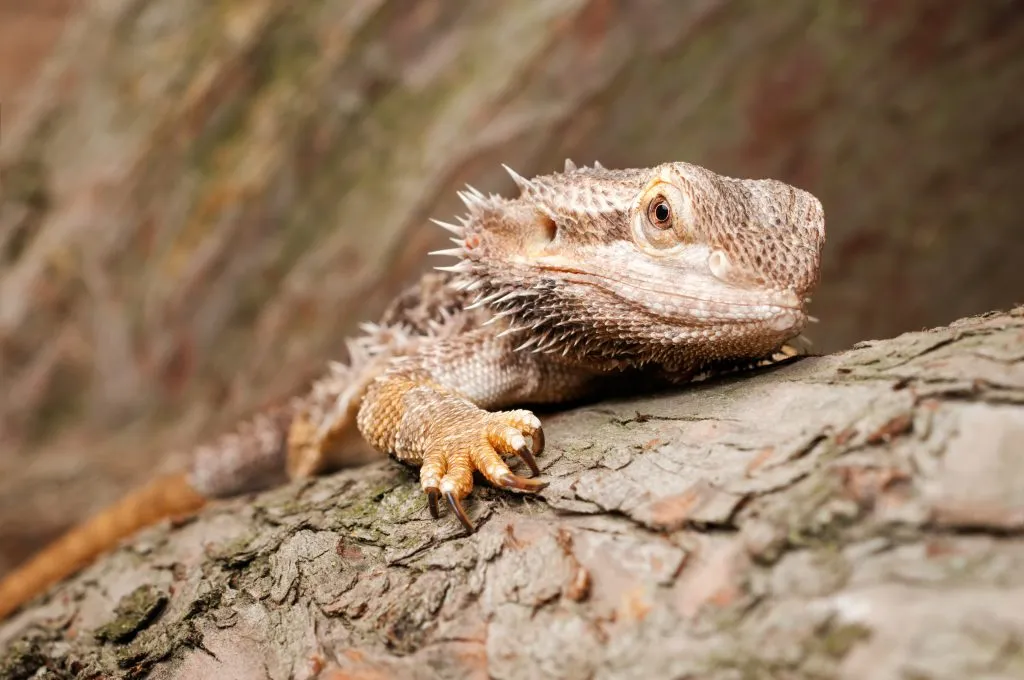
Breeding bearded dragons is not as simple as putting two beardies together in one habitat. Breeding requires careful planning, monitoring, and knowledge of their reproductive habits.
Females should not be bred until they are at least 18 months old or more than 350 grams in weight. They should be paired with males of approximately the same size.
Using a brumation light cycle before planned mating helps increase the female’s receptivity to the male.
If the female is not ready to mate, she will try to escape the male and may be seen clawing at the sides of the
There are many details that you need to know if you are going to successfully breed bearded dragons. Before you embark on such a venture we recommend further research. This wikiHow guide is a good place to start.
A Final Word
Bearded dragons make fantastic pets for beginners, and they can even form bonds with their owners if given enough time. With the right care, bearded dragons are healthy animals that live anywhere from 10-15 years in captivity.
It is important to do your research first before you venture into bearded dragon ownership.
Although they are one of the easiest reptile pets to care for, they do have specific housing and nutrition needs in order for them to remain healthy and happy.
Ultimately, when done correctly, raising these lovable reptiles can be a very rewarding experience.
- Enchi Ball Python: A Unique and Stunning Morph of Python regius - March 27, 2025
- Emerald Tree Monitor: The Enigmatic Green Guardian of the Rainforest - March 26, 2025
- The Egyptian Cobra (Naja haje): A Fascinating Serpent - March 25, 2025
